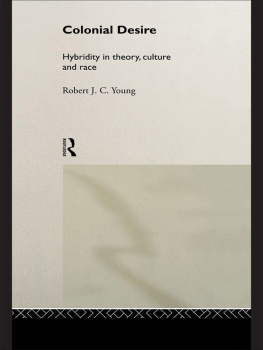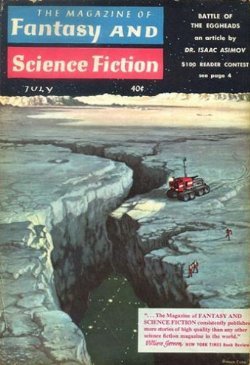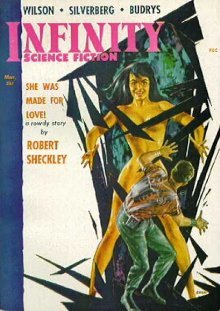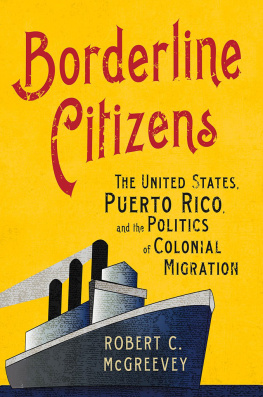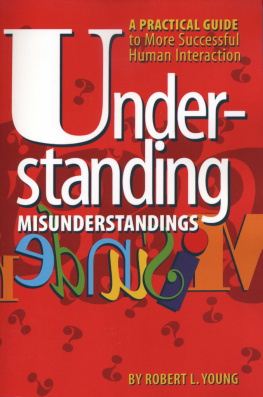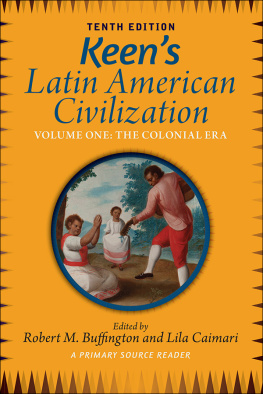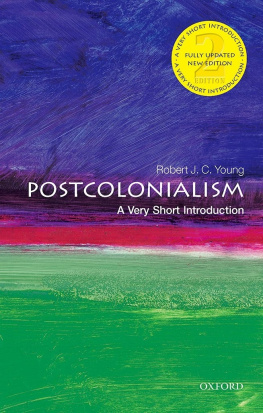Robert J.C. Young - Colonial Desire
Here you can read online Robert J.C. Young - Colonial Desire full text of the book (entire story) in english for free. Download pdf and epub, get meaning, cover and reviews about this ebook. year: 2005, publisher: Taylor and Francis, genre: Romance novel. Description of the work, (preface) as well as reviews are available. Best literature library LitArk.com created for fans of good reading and offers a wide selection of genres:
Romance novel
Science fiction
Adventure
Detective
Science
History
Home and family
Prose
Art
Politics
Computer
Non-fiction
Religion
Business
Children
Humor
Choose a favorite category and find really read worthwhile books. Enjoy immersion in the world of imagination, feel the emotions of the characters or learn something new for yourself, make an fascinating discovery.
- Book:Colonial Desire
- Author:
- Publisher:Taylor and Francis
- Genre:
- Year:2005
- Rating:3 / 5
- Favourites:Add to favourites
- Your mark:
- 60
- 1
- 2
- 3
- 4
- 5
Colonial Desire: summary, description and annotation
We offer to read an annotation, description, summary or preface (depends on what the author of the book "Colonial Desire" wrote himself). If you haven't found the necessary information about the book — write in the comments, we will try to find it.
Colonial Desire — read online for free the complete book (whole text) full work
Below is the text of the book, divided by pages. System saving the place of the last page read, allows you to conveniently read the book "Colonial Desire" online for free, without having to search again every time where you left off. Put a bookmark, and you can go to the page where you finished reading at any time.
Font size:
Interval:
Bookmark:
Despite its overt intentions, argues Robert Young, todays cultural theory repeats and renews many of the key concepts and terms, such as hybridity, through which culture and race have been defined in the past. Young traces the links between the paradigms of todays theory and writings on culture, civilization and racial difference in the nineteenth century. Culture is shown to have worked through an uneasy syncretism, carrying within it an inner dissonance that marks a resistance to Western culture within Western culture itself. Young asserts that Englishness has been less fixed and stable than uncertain, fissured with difference and a desire for otherness.
At the same time, racialized thinking has never been marginal to English culture. Even scientific theories of race were always also theories of cultural difference. Race and culture developed together from the very first. And at the heart of Victorian racial theory, Young discovers colonial desire: an obsession with sexuality, fertility and hybridity: a furtive fascination with miscegenation and inter-racial transgression.
Robert J.C.Young is a Fellow of Wadham College, Oxford, and University Lecturer in English at Oxford University. He is the author of White Mythologies: Writing, History and the West (Routledge 1990).

London and New York
First published 1995
by Routledge
11 New Fetter Lane, London EC4P 4EE
This edition published in the Taylor & Francis e-Library, 2005.
To purchase your own copy of this or any of Taylor & Francis or Routledges collection of thousands of eBooks please go to www.eBookstore.tandf.co.uk.
Simultaneously published in the USA and Canada
by Routledge
29 West 35th Street, New York, NY 10001
1995 Robert J.C.Young
All rights reserved. No part of this book may be reprinted or reproduced or utilized in any form or by any electronic, mechanical, or other means, now known or hereafter invented, including photocopying and recording, or in any information storage or retrieval system, without permission in writing from the publishers.
British Library Cataloguing in Publication Data
A catalogue record for this book is available from the British Library
Library of Congress Cataloging in Publication Data
A catalogue record for this book has been requested
ISBN 0-203-99220-2 Master e-book ISBN
ISBN 0-415-05373-0 (hbk)
ISBN 0-415-05374-9 (pbk)
For Maryam
Coconut palms, banyan trees, golden beaches, rolling surf. A famous musical, set during the Second World War, in the exotic South Seas, with lush songs to match: Some Enchanted Evening, Im Gonna Wash That Man Right Outa My Hair, Honey Bun, Younger than Springtime. A typical, untroubled Orientalist fantasy. I had seen the film as a child but not understood that its plot turned around the question of children.
The film shows us two romances that go wrong. Ensign Nellie Forbush, the nurse from Little Rock, is wooed by the romantic Frenchman, Emile de Becque. No sooner does Nellie finally declare herself to Emile than she notices a line of Polynesian children nearby. She thinks he is joking when he says that they are his. When she realizes that he is not, she jumps into her jeep and goes back to base.
Handsome Lt Joseph Cable from Philadelphia takes the boat to the offlimits romantic island Bali Hai and immediately falls in love with Liat, a beautiful young Polynesian girl. Embracing her passionately, he leaves reluctantly and keeps returning. One day they talk happily about marriage. Until her mother, Bloody Mary, mentions their having children. Cable breaks away, and runs back to his boat. Exotic romance is one thing. But its dusky human consequences are another.
The rest of the film tells of how both Americans learn to overcome their immediate racist reactions of desire and aversion, of simultaneous attraction and repulsion, and come to understand that such racism is not instinctive, but learnt. Cable sings: Youve got to be taught/Before its too late./Before you are six, or seven, or eight./To hate all the people your relatives hate. Too late for what? For the advent of desire.
This is a book that traces the emergence of desire in history, its genealogy and its disavowal in the history of racialized thought. The impresario that stages this patriarchal drama is called culture, itself the production of an emergent capitalist European society; the conflictual structures generated by its imbalances of power are consistently articulated through points of tension and forms of difference that are then superimposed upon each other: class, gender and race are circulated promiscuously and crossed with each other, transformed into mutually defining metaphors that mutate within intricate webs of surreptitious cultural values that are then internalized by those whom they define. Culture has always carried these antagonistic forms of inner dissonance within it: even Englishness has always been riven by its own alterity. And so too racial theory, which ostensibly seeks to keep races forever apart, transmutes into expressions of the clandestine, furtive forms of what can be called colonial desire: a covert but insistent obsession with transgressive, interracial sex, hybridity and miscegenationthe story, in fact, of South Pacific.
I would like to thank the librarians of the Balfour Library at the Pitt Rivers Museum, Oxford, the Bodleian Library, the British Library, the Radcliffe Science Library and Rhodes House Library, for their assistance in tracing the often curious books around which this book is written. Clare Brown gave me the benefit of her comprehensive knowledge of the photographic archives at Rhodes House. I want too to express my gratitude to those who have discussed many of the ideas developed in this book with me and often indicated new, fruitful directions for me to pursue: Philip Barker, Gillian Beer, Gargi Bhattacharyya, Simon Brooks, Theo Dhaen, John Gurney, Catherine Hall, Stephen Howe, Lauren Kassell, John Knight, Kenneth Mills, Tom Paulin, Anita Roy, Mineke Schipper, Gayatri Chakravorty Spivak, Lynnette Turner and Megan Vaughan. I would also like to take this opportunity of thanking the following for their comradeship and support, both in the past at Southampton and still in the present: Isobel Armstrong, who made it all possible, Derek Attridge, Joe Bristow, Tony Crowley, Maud Ellmann, Ken Hirschkop, Kadie Kanneh, Jo McDonagh, Laura Marcus, Bill Marshall, Peter Middleton, Jonathan Sawday, Lindsay Smith and Clair Wills. Matthew Meadows has interrogated and augmented my cultural preoccupations over many years with characteristic energy and warmth. Homi Bhabha has taken a close interest in this project and as always has offered valuable criticisms and advice; I am indebted to him for his challenging, friendly companionship. Lastly, my very special thanks to Badral Young.
Grateful acknowledgement is given to the Bodleian Library to reproduce illustrations from the following: Robert Knox, The Races of Men (1850), 1902. e. 48, pp. 40, 52; John Beddoe, The Races of Britain, (1885), 1902. d. 86, facing p. 252; Bryan Edwards, The History, Civil and Commercial, of the British Colonies in the West Indies (1793), PP. 61. C. TH, engraving entitled The Sable Venus; Arthur W.Read, Photographic Album, MS.Afr. 1493, Folio 2 verso, top, Picnic (?).
Walk through the majestic iron gates with which Greenwich Park faces the river Thames, and make your way up the steep grassy hill which overlooks the Isle of Dogs, and the level, desolate flats of East London. Follow the snaking, restless river westwards towards Rotherhithe, where the Mayflower pub irreverently marks the spot from which the puritanical Pilgrim Fathers emigrated to America in 1620. Keep climbing upwards, taking care not to stumble against the roots of any trees. As you reach the top, you find yourself standing before a large eighteenth-century building with elegant Georgian windows over-looking the river. You are facing the Old Royal Observatory, Greenwich. Walk round its walls until you come to a brass strip set in the pavement. The smooth, gold band in the ground marks the Prime Meridian, or Longitude Zero. At the top of this small hill, you have found yourself at the zero point of the world, at the centre of time itself. Paradoxically, for Greenwich to be the centre of the world in time it must be inscribed with the alterity of place. Stand to the left-hand side of the brass strip and you are in the Western hemisphere. But move a yard to your right, and you enter the East: whoever you are, you have been translated from a European into an Oriental. Put one foot back to the left of the brass strip and you become undecidably mixed with otherness: an Occidental and an Oriental at once. It was with a supremely knowing gesture towards the future that in 1884, the division of the newly homogenized temporal world into East and West was placed not in Jerusalem or Constantinople but in a South London suburb. In that gesture, it was acknowledged that the totality, the sameness of the West will always be riven by difference. With each passing decade London has been ever more successful in living up to its officially proclaimed heterogeneous identity, so that now, turning back towards the river and looking down at the park laid out below you, at the Londoners stretched out on the grass or wandering to and fro according to trajectories unknown to anyone except themselves, just walking home or coming and going from one country to the next, you could scarcely imagine a more varied mingling of peoples, whose ancestors hark back to the Caribbean and Africa, India, Pakistan, Bangladesh, China, Tibet, Afghanistan, Somalia, the Balkans, mixed and merged with others whose predecessors turned up in the British Isles as Angles, Celts, Danes, Dutch, Irish, Jews, Normans, Norsemen, Saxons, Vikings. The cleavage of East and West in that bronze strip on the hill has gradually been subsumed into a city that, with the potent attraction of economic power exerting the magnetic field of force of the North over the South, has drawn the far-off peripheries into the centre. And with that historic movement of intussusception, the Prime Meridian, the Longitude Zero, the centre of the world, has become inalienably mixed, suffused with the pulse of difference.
Font size:
Interval:
Bookmark:
Similar books «Colonial Desire»
Look at similar books to Colonial Desire. We have selected literature similar in name and meaning in the hope of providing readers with more options to find new, interesting, not yet read works.
Discussion, reviews of the book Colonial Desire and just readers' own opinions. Leave your comments, write what you think about the work, its meaning or the main characters. Specify what exactly you liked and what you didn't like, and why you think so.

